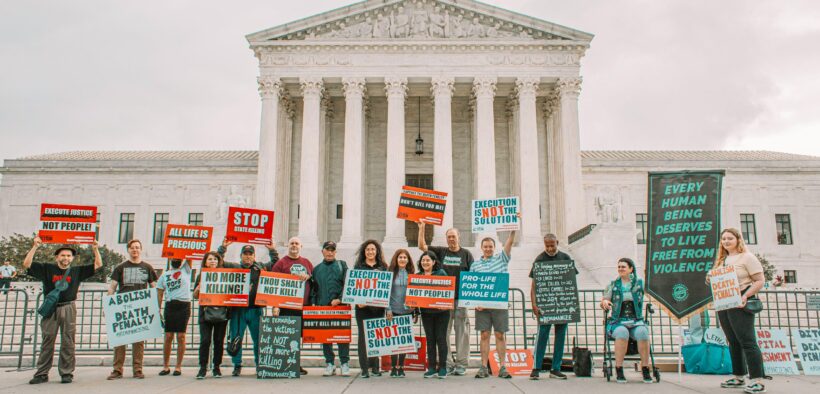Life or Death: An Examination of Capital Punishment
Share

Image Credits: @mcoswalt on Unsplash (Unsplash License)
Historical Context
The death penalty has been a part of American society since its colonial beginnings. Early colonists brought the practice from Europe, with the first execution documented in Virginia in 1608. Throughout the colonial era, the death penalty was used for various crimes. Even then, questions about its morality and effectiveness began to surface. While reforms in the 19th century reduced the number of capital offenses in some states, the death penalty remained a prevalent feature of the criminal justice system.
The 20th century experienced a more dramatic shift in attitudes. Despite a surge in executions during the 1930s, public sentiment started turning against capital punishment in the following decades. In 1972, the holding of Furman v. Georgia resulted in a temporary suspension of the death penalty. However, the punishment was reinstated four years later in Gregg v. Georgia. This fueled negative perceptions of the death penalty, with concerns about the execution of juveniles and people with mental disabilities, racial bias, and more. Additionally, the international community began moving towards abolition, with many countries outlawing the use of the death penalty.
Public support for capital punishment has also seen a decline in recent years, with people favoring alternative punishments, such as life in prison without parole. Moreover, international organizations like the United Nations advocate for a worldwide abolition of executions, reflecting a shift in global views. Despite these developments, the death penalty remains a highly debated topic in the United States, with no easy answers to questions about its effectiveness and fairness. This has led to a divide, with some states frequently employing the punishment and others seeking alternative approaches.
Texas’ Death Penalty Machine
Out of the 50 states, Texas leads the nation with 570 executions since 1977, accounting for over a third of the United States’ total executions during that time frame. According to a poll conducted by the University of Texas, about 63% of registered voters are in favor of the death penalty for offenders convicted of violent crimes. People may hold these beliefs for various reasons, but the death penalty’s entrenchment within American culture may contribute to these views. For instance, criminologist David Garland asserts that people’s attitudes toward punitive measures may be reinforced through their “fear of crime, hatred of heinous criminals, racist attitudes and an uncaring contempt for marginalized groups and ‘underclasses.’” Such factors cause people to develop retribution-based perspectives driven by their understanding of justice. However, this can also incorporate social biases, creating issues of discrimination within the criminal justice system.
Furthermore, offenders in Texas lack access to an adequate public defender system, resulting in more death penalty sentences for those who cannot afford a lawyer. American lawyer Stephen Bright states, “The Court of Criminal Appeals repeatedly appointed lawyers who were incapable of preparing petitions and filing them on time.” This highlights a significant issue, as inexperienced lawyers represent defendants in cases with high stakes. With minimal practice, attorneys may miss constitutional violations or overlook evidence, creating a subpar defense for their clients. One of the main reasons for this is insufficient funding, resulting in offices having few public defenders and causing lawyers to become overwhelmed with work. Based on federal law, defendants may have two attorneys representing them in a capital case, one of whom is well-versed in this particular area of law. However, given the current state of affairs, offenders would be lucky to be represented by one decent lawyer. This system fosters an environment where justice becomes a lottery. Access to legal representation becomes a determining factor, often resulting in outcomes that favor the wealthy.
Additionally, the majority of individuals sentenced to the death penalty are people of color, showcasing the racial injustices of this punishment. As of April, white people only account for 24.7% of death row, in contrast to Black people, who make up the plurality with 46.1%. Similar to incarceration populations, Black people are overrepresented on death row, which implies that underlying biases may affect the severity of one’s sentence. While the racial discrepancies among offenders are evident, this extends to the race of victims and the perpetrator’s sentencing. For instance, prosecutors are more likely to seek capital punishment when a defendant’s victim is white. This is an unfortunate reality, as those who murder a Black person may serve a prison sentence, whereas someone who commits the same crime against a white individual could face execution. Based on this, Texas does not follow the principle of punishment regarding equity since similar crimes could result in different sentences. The prevalence of racism throughout Texas’ criminal justice is concerning as this disproportionately targets certain groups of people, jeopardizing their equal protection under the law.
Moreover, Texas’ court system includes elected judges, but this political aspect can compromise their impartiality and rulings in capital cases. Proponents believe that elected judges increase public trust in the judiciary, as judges are accountable to the people and tend to reflect their values. However, this very principle can backfire, and Bright argues that partisan judges are inadequate since they cater their rulings toward constituents to stay in power. Since many Texans are in favor of capital punishment, judges are more likely to adopt a tough-on-crime stance and affirm death penalty sentences. For example, appointed judges overturn around 26% of capital cases, while elected judges only do so 11% of the time. The majority of states that still use the death penalty also have elected judges, which could imply that this issue is not limited to jurisdictions in Texas. Therefore, the differences in rulings suggest that the politicization of the courts can significantly influence a judge’s decision.
With a flawed criminal justice system, mistakes are inevitable and can cause innocent people to be punished for crimes they did not commit. In 1989, Carlos DeLuna was executed for the murder of Wanda Lopez, a clerk at a local convenience store. Later on, a team of researchers at Columbia Law School investigated this case, proving that DeLuna was innocent. During his trial, DeLuna claimed that another Carlos was responsible for this murder: Carlos Hernandez. However, the prosecutor deemed Hernandez a “phantom” of DeLuna’s imagination, portraying DeLuna as guilty beyond reasonable doubt. This case highlights the ramifications of Texas’ criminal justice system. Instead of devoting adequate resources to investigating crimes, innocent people are accused and sentenced to death. DeLuna’s case is a tragedy, but with a system plagued by racial and legal disparities, there are sure to be other victims. Thus, it is essential to consider whether Texas’ use of the death penalty results in justice or is merely a tool to assert power and dominance.
Why This Matters
The death penalty’s persistence forces the criminal justice system to consider its objectives. While retribution is one aspect of the system, solely focusing on punishment fails to address the root causes of crime. Conversely, incorporating restorative justice and rehabilitation programs could offer a more holistic approach. These alternatives allow offenders to take responsibility for their actions, potentially offering victims closure and fostering a sense of accountability. Ultimately, a reformed criminal justice system should aim to prevent future crimes with the possibility of redemption – a virtue that the death penalty simply strips away. By prioritizing these practices alongside appropriate punishment, the system can strive to promote public safety and social well-being more effectively.
That being said, the future of the death penalty remains uncertain. Growing pressure for abolition, in addition to ethical concerns, suggests a potential decline in its use. Nevertheless, some members of the public and victims’ families may continue to advocate for the death penalty as a just retribution for certain crimes. Additionally, the debate about federal versus state administration of capital punishment adds another layer of complexity. Overall, fostering conversations and developing comprehensive policies are essential for determining the appropriate role of the death penalty in criminal law.


Want to get involved?
Connect with us! Connect with us!